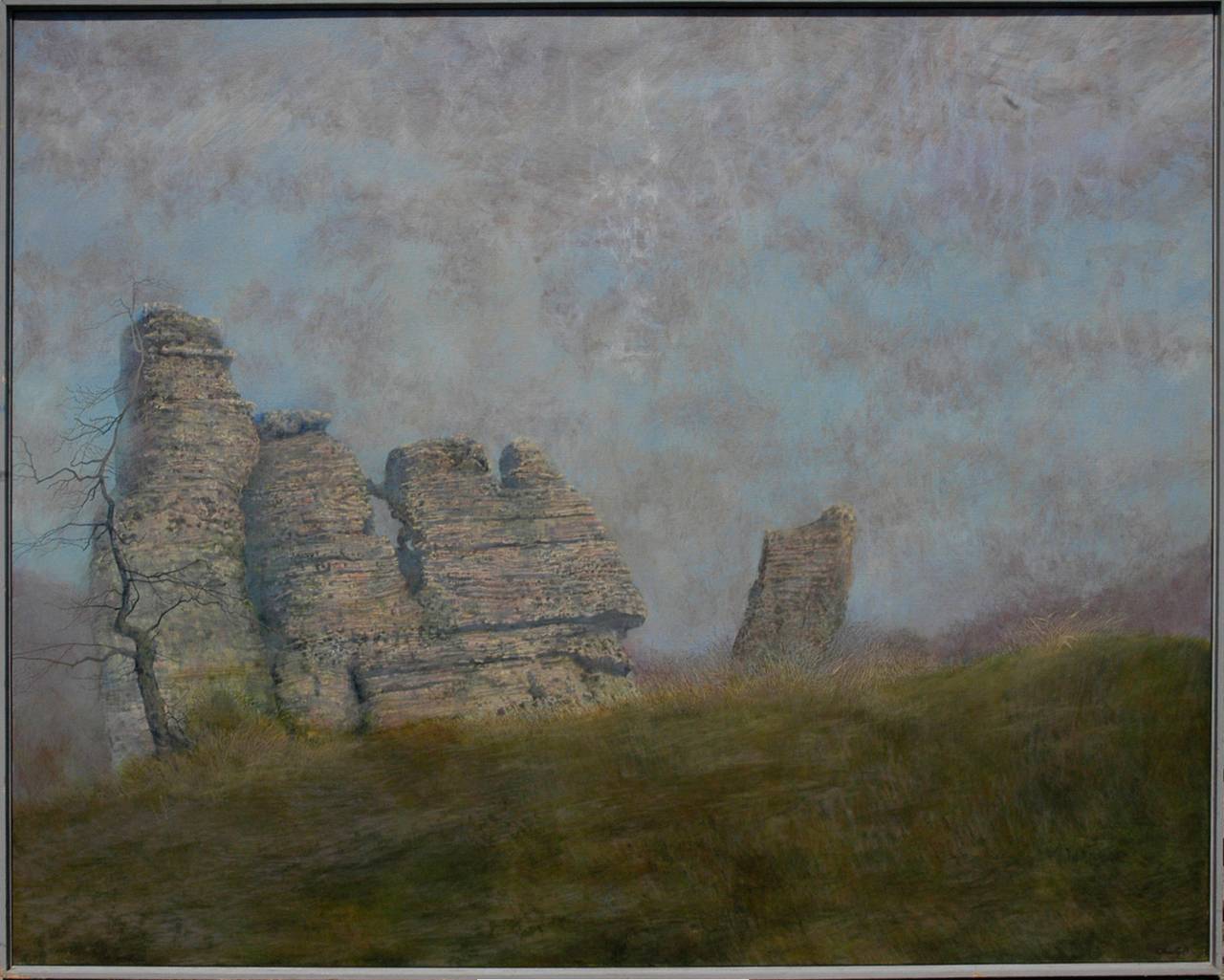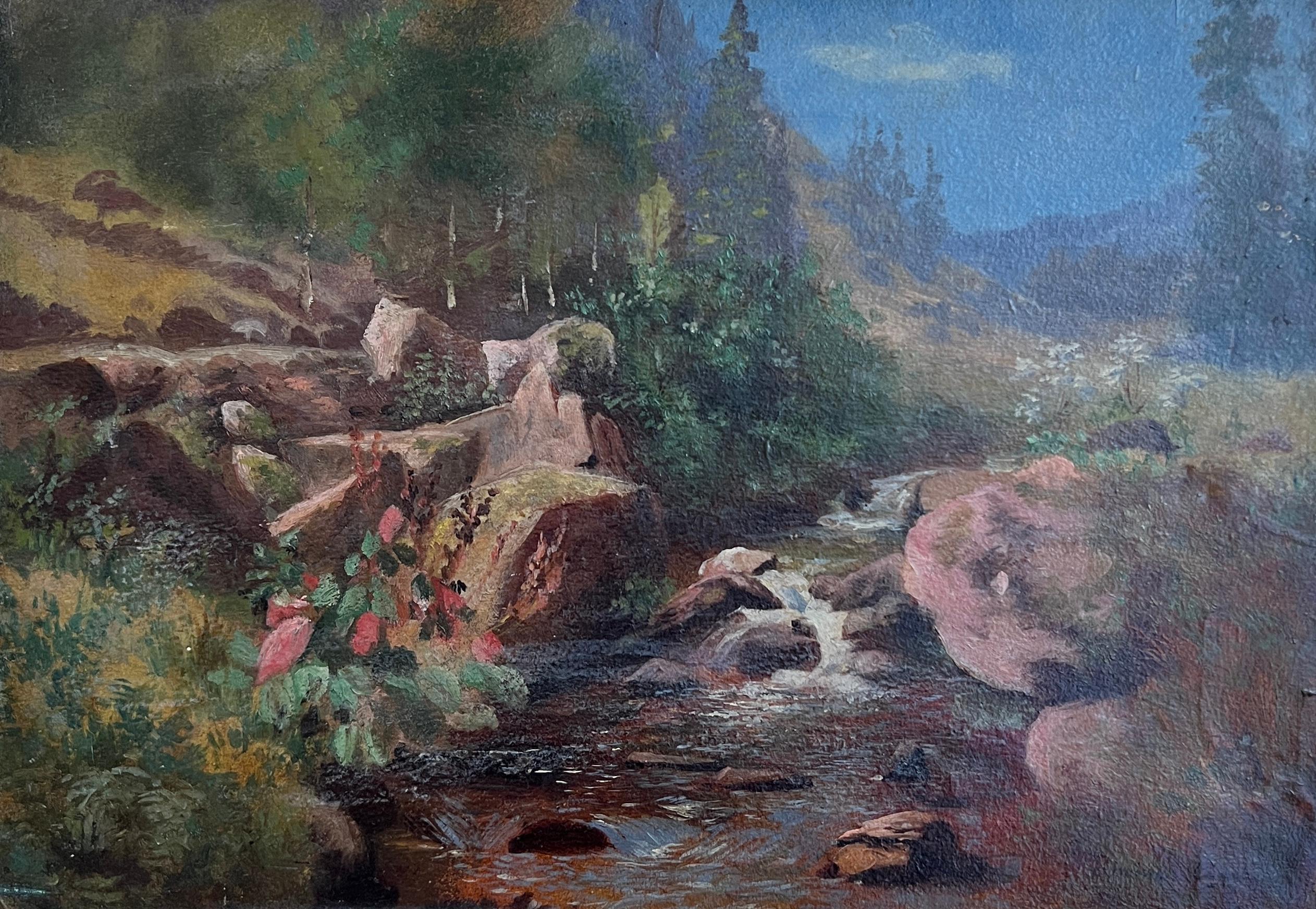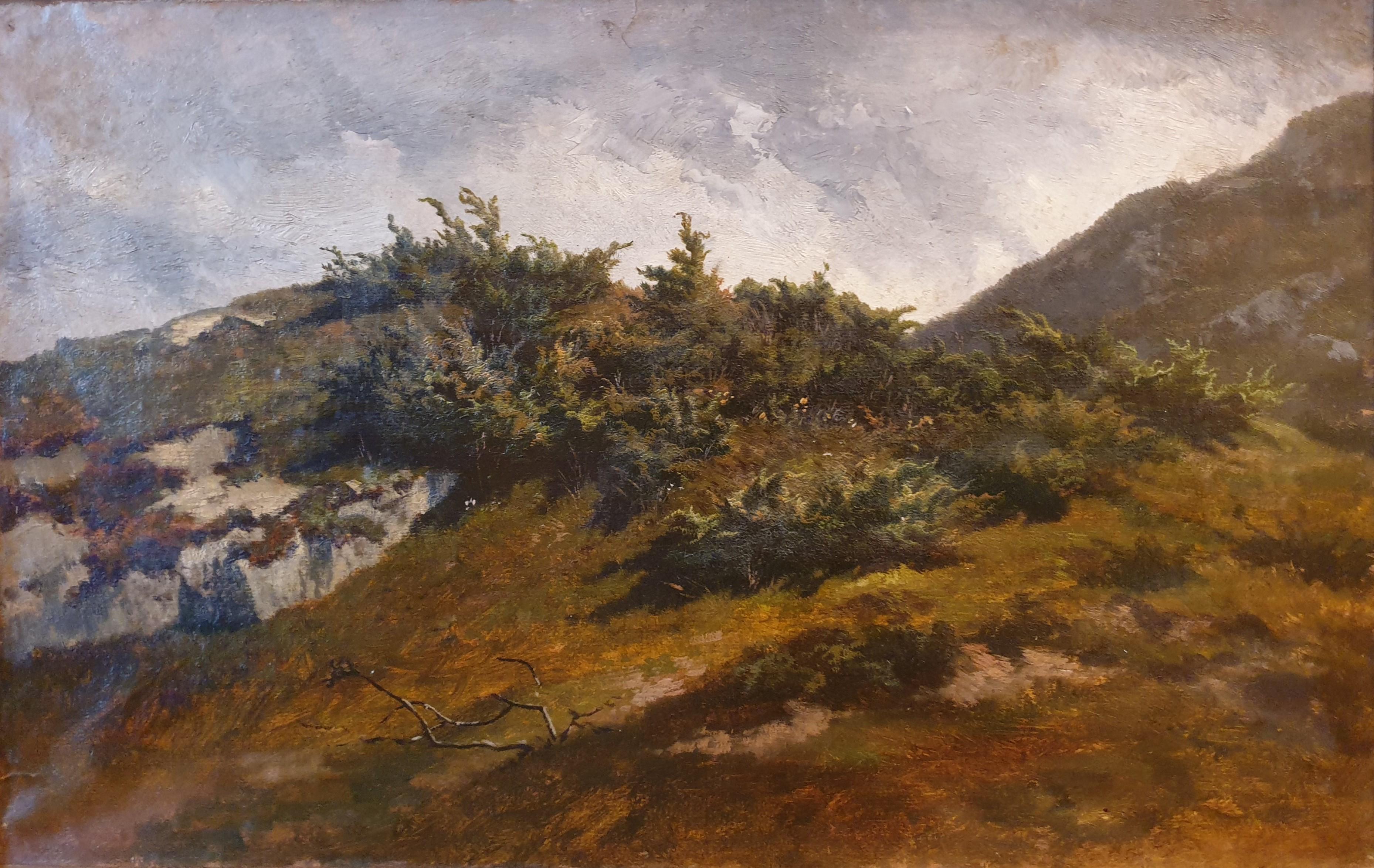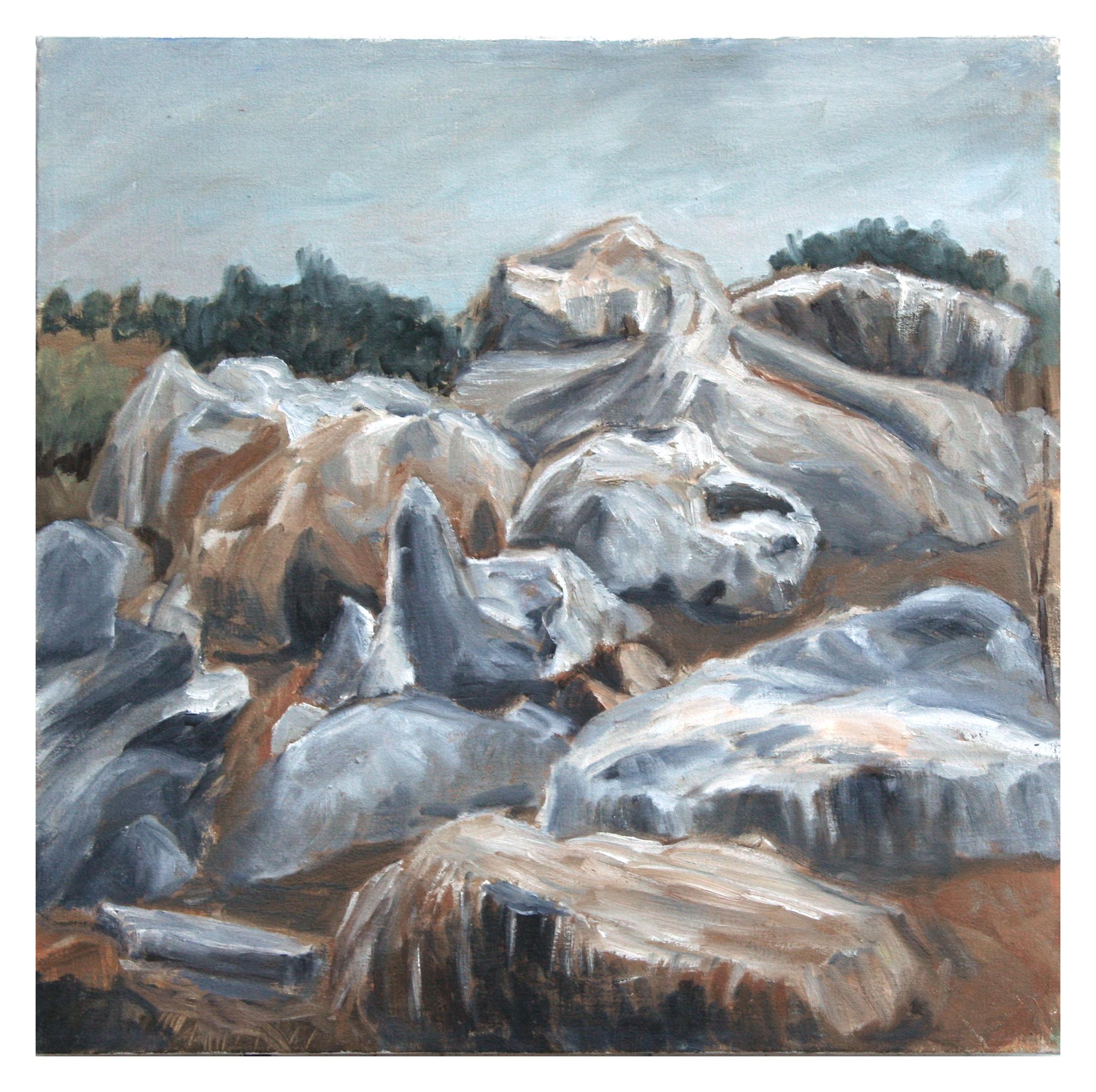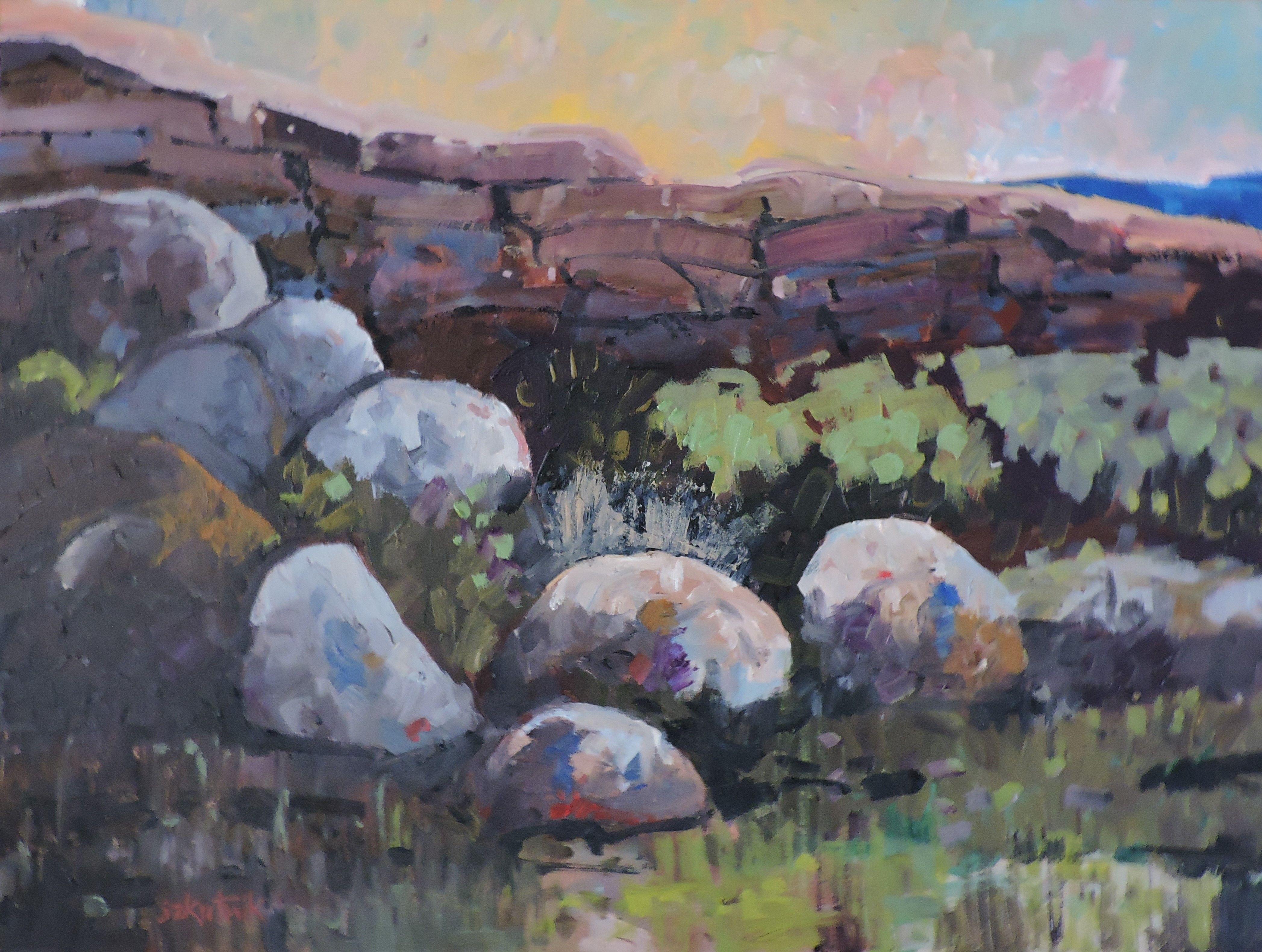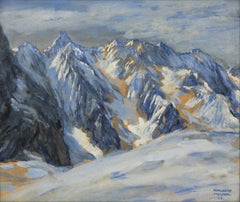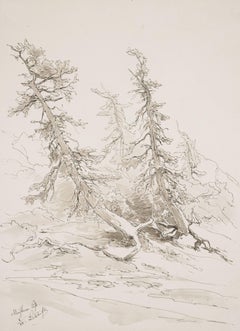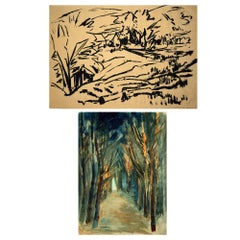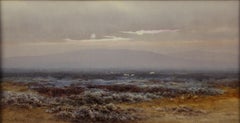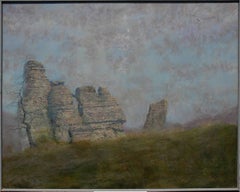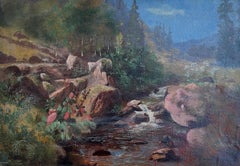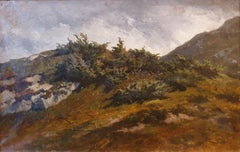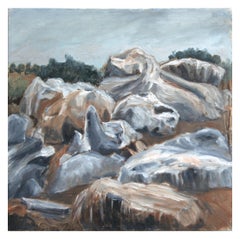Items Similar to Low Mountain Landscape with Rocks - The mystery of an inconspicuous place -
Want more images or videos?
Request additional images or videos from the seller
1 of 9
Heinz RoderLow Mountain Landscape with Rocks - The mystery of an inconspicuous place -1934
1934
$693.62
£512.92
€580
CA$959.87
A$1,068.25
CHF 556.16
MX$12,900.32
NOK 6,974.74
SEK 6,588.08
DKK 4,417.67
About the Item
Heinz Roder (1895-1965), Low Mountain Landscape with Rocks, oil on painting cardboard, 30 x 40 cm (visual size), 40 x 50 cm (frame), signed and dated "[19]34" at lower right. In a decorative stucco frame of the period.
- Small chip at lower left margin, craquelure in the upper area.
About the artwork
Heinz Roder depicts a low mountain range landscape, but there is no mountain panorama or distant view. He takes us to a place just below the tree line, on the crest of a hill. The fir trees descending into the background make it clear that it is downhill again. Instead of a view of the surrounding landscape, there is a huge rock in the foreground which, together with the firs, restricts the view. Roder transforms what is normally a wide mountainous landscape into a close-up view, following the eighteenth-century practice of blocking the view in order to enhance the intimacy of the depicted idyll.
Here, however, we are not looking at a locus amoenus, the beautiful place of a restored paradise, but at a rugged landscape with mighty rocks, as it appears in the play of colours. The blue-grey rocks and the ochre-yellow grasses are contrasted by the blue-yellow sky. With the blue-gray rocks and the ocher-yellow grasses the blue-yellow complementary contrast is leading, in which also the sky inserts itself. There is also the dark green of the fir trees, which combines with the mossy growth of the rocks.
With a very reduced palette, Roder has succeeded in creating a colour harmony rich in tension, which also incorporates the contrast in the texture of the landscape: the delicate soft grasses flow around the hard rock formation. Roder evokes these material qualities with a free, almost sketchy, impressionistic line. The grasses are vertically oriented, quick successions of strokes, while the rocks are horizontal layers of strokes. This creates a fluctuating moment that gives the landscape its specific liveliness and brings the aura of the place into the picture.
Thank you for your interest! I hope I have been able to explain to you the special character of the artwork. If you have any questions of any kind, please feel free to contact me.
I wish you many more discoveries in the realm of art,
Dr Martin Kirves
GERMAN VERSION
Heinz Roder (1895-1965), Mittelgebirgslandschaft mit Felsen, Öl auf Malkarton, 30 x 40 cm (Sichtmaß), 40 x 50 cm (Rahmen), unten rechts signiert und "[19]34" datiert. In dekorativem Stuckrahmen der Zeit.
- kleine Abplatzung im unteren linken Randbereich, Craquele im oberen Bereich
zum Werk
Heinz Roder veranschaulicht eine Mittelgebirgslandschaft, die allerdings kein Bergpanorama oder einen Ausblick in die Ferne zeigt. Er versetzt uns an einen etwas unterhalb der Baumgrenze angesiedelten Ort auf der Kuppe einer Anhöhe. Die in den Hintergrund hinein absteigenden Tannen verdeutlichen, dass es dort wieder bergab gehen wird. Anstelle der Aussicht in die umliegende Landschaft erhebt sich im Bildvordergrund ein mächtiger Felsen, der zusammen mit den Tannen das Blickfeld begrenzt. Roder wandelt die üblicherweise weite Gebirgslandschaft in eine nahsichtige Szenerie und folgt damit der sogenannten gesperrten Landschaft des 18. Jahrhunderts, die den Blick im Nahbereich hält, um die Intimität der dargestellten Idylle zu steigern.
Hier sehen wir jedoch nicht einen locus amoenus, den lieblichen Ort eines wiederhergestellten Paradieses, sondern beschauen die mit dem mächtigen Felsen durchaus raue, von archaischen Kräften geprägte Landschaft wie sie sich im Spiel der Farben darbietet. Mit den blaugrauen Felsen und den ockergelben Gräsern ist dabei der Blau-Gelb Komplementärkontrast leitend, in den sich auch der Himmel einfügt. Hinzu kommt das sich mit dem moosartigen Bewuchs des Felsens verbindende Dunkelgrün der Tannen.
Mit einer stark reduzierten Palette gelingt es Roder, eine in sich spannungsreiche Farbharmonie zu erzeugen, in die auch der Kontrast der Beschaffenheit der Landschaft eingeht: Die filigranen weichen Gräser umfließen die harte Felsformation. Diese materiellen Qualitäten evoziert Roder mit einem freien, beinahe skizzenhaften impressionistischen Duktus. Die Gräser sind vertikal ausgerichtete schnelle Strichfolgen, während die Felsen aus horizontalen Strichschichtungen bestehen. Dadurch entsteht ein fluktuierendes Moment, das der Landschaft ihre spezifische Lebendigkeit verleiht und die Aura des dargestellten Ortes ins Bild setzt.
Vielen Dank für Ihr Interesse! Ich hoffe, ich habe Ihnen den besonderen Charakter des Kunstwerks näherbringen können. Bei Fragen jeglicher Art können Sie mich gerne kontaktieren.
Ich wünsche Ihnen noch viele Entdeckungen im Reich der Kunst,
Dr. Martin Kirves

About the Seller
5.0
Vetted Professional Seller
Every seller passes strict standards for authenticity and reliability
Established in 2014
1stDibs seller since 2023
21 sales on 1stDibs
- ShippingRetrieving quote...Shipping from: Berlin, Germany
- Return Policy
Authenticity Guarantee
In the unlikely event there’s an issue with an item’s authenticity, contact us within 1 year for a full refund. DetailsMoney-Back Guarantee
If your item is not as described, is damaged in transit, or does not arrive, contact us within 7 days for a full refund. Details24-Hour Cancellation
You have a 24-hour grace period in which to reconsider your purchase, with no questions asked.Vetted Professional Sellers
Our world-class sellers must adhere to strict standards for service and quality, maintaining the integrity of our listings.Price-Match Guarantee
If you find that a seller listed the same item for a lower price elsewhere, we’ll match it.Trusted Global Delivery
Our best-in-class carrier network provides specialized shipping options worldwide, including custom delivery.More From This Seller
View AllWettersteinkamm - The blue of the mountains -
Located in Berlin, DE
Adalbert Holzer (1881 Munich - 1966 Munich). Wettersteinkamm. Watercolour, 29 x 34.5 cm (visible size), 37.5 x 43 cm (frame), signed and dated at lower right 'ADALBERT HOLZER [19]23'.
Framed behind glass. Frame shows signs of wear.
- The blue of the mountains -
About the artwork
The Wetterstein ridge is revealed to the viewer from a gentle, snow-covered hill. In contrast to conventional depictions of mountains, the painting is composed entirely of shades of blue, which condense into the blue-grey of the rock or fade into the white of the snow. As a complementary colour to the blue, Holzer virtuously activates the ochre ground. The uniform yet exciting polarity of the colours emphasises the massive majesty of the mountains and at the same time underlines the special character of the Wetterstein ridge. Holzer transferred the translucency of glass painting, in which he was originally trained, to watercolour and developed a pictorial language related to the art of Ferdinand Hodler, which earned him the nickname 'Master of Blue' and led to the appreciation of his watercolours in particular.
About the artist
After an apprenticeship as a stained glass painter at the Kunstgewerbeschule, Adalbert Holzer studied at the Munich Art Academy under Carl von Marr...
Category
1920s Realist Landscape Drawings and Watercolors
Materials
Watercolor
$908 Sale Price
20% Off
Woodland / - The Inner Drama of the Landscape -
Located in Berlin, DE
Eduard Peithner von Lichtenfels (1833 Vienna - 1913 Berlin), Woodland, 1884. Watercolor and pen and ink on drawing paper, 30.4 cm x 22.5 cm, signed, dated and inscribed by the artist...
Category
1880s Landscape Drawings and Watercolors
Materials
Paper
Landscape verso Forest interior / - Landscape as a space of imagination -
Located in Berlin, DE
Herbert Seidel (1906 Berlin - 1974 Rüdersdorf), Landscape verso Forest interior, around 1950. India ink on grained, bleached paper, 40.5 x 58 cm, signed “Herbert Seidel” in pencil on...
Category
1950s Abstract Landscape Drawings and Watercolors
Materials
Paper
High Moorland Landscape in the fog - The world as a transcendent phenomenon -
Located in Berlin, DE
Charles Edward Brittan Jr (1870 Plymouth - 1949). High moor landscape in the fog. Gouache, signed at lower left "Charles E. Brittan", 18 x 34.5 cm (passepartout), 45 x 62 cm (frame)....
Category
Early 20th Century Realist Landscape Drawings and Watercolors
Materials
Watercolor
$1,722 Sale Price
20% Off
Impressionist Autumn Landscape with Lake / - Diffuse Concretion -
Located in Berlin, DE
Wilhelm Feldmann (1859 Lüneburg - 1932 Lübeck), Impressionist autumn landscape with lake, around 1905. Pastel on cardboard, 46 cm x 31 cm (inside dimension), 52 cm x 37 cm (frame), s...
Category
Early 1900s Impressionist Landscape Paintings
Materials
Gouache
S. Anton Patenkirchen / - The Home of the Landscape -
Located in Berlin, DE
Hans Thoma (1839 Bernau - 1924 Karlsruhe), S. Anton Patenkirchen, 1895. Algraph on strong wove paper, published by Breitkopf und Härtel in Leipzig as ‘Zeitgenössisches Kunstblatt Nr....
Category
1890s Realist Figurative Prints
Materials
Paper
You May Also Like
"Rock Forms in Open Field" Ancient Rock Formations by Charles Brindley
By Charles Brindley
Located in Soquel, CA
"Rock Forms in Open Field" Ancient Rock Formations by Charles Brindley
Large scale and substantial landscape titled, "Rock Forms in Open Field" by Charles Brindley (American, b. 195...
Category
1980s Photorealist Landscape Paintings
Materials
Canvas, Oil
$3,925 Sale Price
34% Off
Mountain landscape and small stream
Located in Genève, GE
Work on canvas Swiss lanscape
Golden wooden frame
42.5 x 55 x 4 cm
This splendid painting is an ode to the magnificence of nature. Dominated by a palette of lush greens and deep blue...
Category
Early 20th Century Landscape Paintings
Materials
Oil
Mountain landscape 19th ODIER Swiss realist painting sketch
Located in PARIS, FR
Jacques Louis ODIER
Geneva, 1853 - Vevey, 1930
Oil on paper on canvas
34 x 54 cm (47 x 66.5 cm with frame)
Countersigned on the verso "Odier"
Exhibition number on the verso “249”
Bea...
Category
19th Century Realist Landscape Paintings
Materials
Oil
Rocky Formation Landscape
Located in Soquel, CA
Dramatic rocky formation landscape in this interesting painting by Trevor Lewis Andrews (American, 20th c.) Signed "Trevor Andrews 2012" on verso. Unframed. Image, 18"H x 18"L.
Trevor Andrews is a young, up and coming...
Category
Early 2000s American Impressionist Landscape Paintings
Materials
Canvas, Oil
$440 Sale Price
20% Off
Ancient Stones - forest landscape painting
Located in Zofingen, AG
The forest painting with the mountains and stones is a beautiful wall decor, the painting is created en plein air, the artwork is full of different bright colours, combinations of wa...
Category
2010s Impressionist Landscape Paintings
Materials
Oil, Board
Boulders and Rocks, Painting, Oil on Other
By Richard Szkutnik
Located in Yardley, PA
original oil on panel for holiday season painting is priced $435.00 from original value $865.00 :: Painting :: Impressionist :: This piece comes with an official certificate of auth...
Category
2010s Impressionist Landscape Paintings
Materials
Oil
More Ways To Browse
German Mountain Landscape
Oil Paintings Of Battle
Romanticism Painting
Impressionist Paintings Marine
Paintings By William Henry
Salmagundi Club
English Countryside Framed
76 Oil Painting
Impressionist Paris Street Scenes
John Richard Framed
Plein Air Gold Frame
American Farm Oil Paintings
Joan Maier
Mid Century Seascape
French Impressionist Sketch
The 21 Club
Irish School
Beach Scene Watercolor
